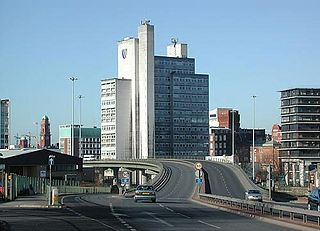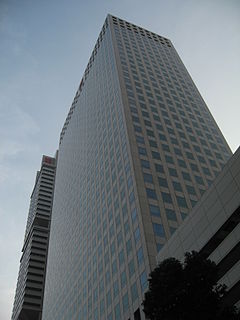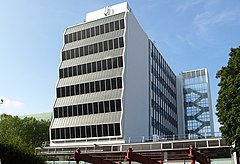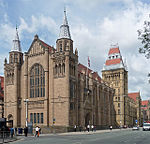
The University of Manchester Institute of Science and Technology (UMIST) was a university based in the centre of the city of Manchester in England. It specialised in technical and scientific subjects and was a major centre for research. On 1 October 2004, it amalgamated with the Victoria University of Manchester to produce a new entity called the University of Manchester.

The Barbican Estate is a residential complex of around 2,000 flats, maisonettes, and houses within the City of London in Central London, in an area once devastated by World War II bombings and densely populated by financial institutions. Originally built as rental housing for middle and upper-middle class professionals, it remains to this day an upmarket residential estate. It contains, or is adjacent to, the Barbican Arts Centre, the Museum of London, the Guildhall School of Music and Drama, the Barbican public library, the City of London School for Girls and a YMCA, forming the Barbican Complex.

The University of Salford is a public university in Salford, Greater Manchester, England, 1 mile west of Manchester city centre. The Royal Technical Institute, Salford, which opened in 1896, became a College of Advanced Technology in 1956 and gained university status in 1967, following the Robbins Report into higher education.

Brutalist architecture, or New Brutalism, is an architectural style which emerged during the 1950s in Great Britain, among the reconstruction projects of the post-war era. Brutalist buildings are characterised by minimalist constructions that showcase the bare building materials and structural elements over decorative design. The style commonly makes use of exposed concrete or brick, angular geometric shapes and a predominantly monochrome colour palette; other materials, such as steel, timber, and glass, are also featured.

Manchester Town Hall is a Victorian, Neo-gothic municipal building in Manchester, England. It is the ceremonial headquarters of Manchester City Council and houses a number of local government departments. The building faces Albert Square to the north and St Peter's Square to the south, with Manchester Cenotaph facing its southern entrance.

Wilmslow Road is a major road in Manchester, England, running from Parrs Wood northwards to Rusholme. There it becomes Oxford Road and the name changes again to Oxford Street when it crosses the River Medlock and reaches the city centre.

The Liverpool Playhouse is a theatre in Williamson Square in the city of Liverpool, England. It originated in 1866 as a music hall, and in 1911 developed into a repertory theatre. As such it nurtured the early careers of many actors and actresses, some of whom went on to achieve national and international reputations. Architectural changes have been made to the building over the years, the latest being in 1968 when a modern-style extension was added to the north of the theatre. In 1999 a trust was formed, joining the management of the Playhouse with that of the Everyman Theatre.

103 Colmore Row, formerly known as National Westminster House, was a building on Colmore Row, Birmingham, England. The original building was designed by John Madin and was completed in October 1975 as offices and a banking hall for National Westminster Bank. After National Westminster Bank vacated the building it passed through several ownerships but failed to lease its offices. In 2008 a plan by then owners British Land to demolish the tower and replace with a taller modern equivalent was approved. This plan never progressed and the building passed to the developer Sterling Property Ventures, who successfully applied to have the building demolished and a new tower constructed in 2015. Demolition began in July 2015 and was completed in January 2017.

The Attenborough Building is the tallest building on the campus of the University of Leicester, and houses arts and humanities departments.

The Maths and Social Sciences Building is a high-rise tower in Manchester, England. It was part of the University of Manchester Institute of Science and Technology (UMIST) until that university merged with the Victoria University of Manchester, to form the University of Manchester, in 2004. It was vacated by the university in 2010 but is currently in use by the School of Materials while waiting for a new building to be constructed.

The Barnes Wallis Building/Wright Robinson Hall is a university building in central Manchester. It forms part of the campus of the former University of Manchester Institute of Science and Technology, which merged in 2004 with the nearby Victoria University of Manchester.

The Keele Campus of York University in the North York district of Toronto, Ontario, Canada, occupies roughly 1 square kilometre of land and is situated between Jane Street to the west, Keele Street to the east, Steeles Avenue West to the north and Finch Avenue West to the south. The campus itself is located in North York, now a census division within the City of Toronto. It is the largest post-secondary campus in Canada at 457 acres.

OUE Downtown or 6 Shenton Way, formerly DBS Building Towers is a high-rise skyscraper complex at 6 Shenton Way in the central business district of Singapore. Tower 1, at 201 metres (659 ft) and 50 storeys, was completed in 1975 and is one of Singapore's oldest skyscrapers. Tower 2, at 150 m (490 ft) and 36 storeys, was completed twenty years later in 1994. The former headquarters of DBS Bank was located in the complex. Overseas Union Enterprise (OUE) acquired the complex in 2010 and renamed it 'OUE Downtown'.

The Didsbury Campus on Wilmslow Road, Didsbury, Manchester, England, originally a private estate, was part of the Manchester Metropolitan University; the oldest building on the site dated to around 1785. It became a theological college for the Wesleyan Methodist Church in 1842, about the same time as a chapel which later became part of the college was built. These buildings are now all listed.

The Theatre Royal in Manchester, England, opened in 1845. Situated next to the Free Trade Hall, it is the oldest surviving theatre in Manchester. It was commissioned by Mancunian businessman John Knowles who wanted a theatre venue in the city.

The Mathematics Building in Manchester, England, was a university building which housed the Mathematics Department of the Victoria University of Manchester and briefly the newly amalgamated University of Manchester from 1968 to 2004. The building consisted of a three-storey podium and an 18-storey 75 metre tower. It was designed by local architect Scherrer and Hicks in a quirky combination of 1960s-brutalism and international style modernism architecture. It was demolished in 2005 as the maths department moved to the Alan Turing Building on Upper Brook Street.

Southport Arts Centre, formerly known as Cambridge Hall, is on the east side of Lord Street, Southport, Sefton, Merseyside, England, and stands between Southport Town Hall and the Atkinson Art Gallery and Library. It was built in 1873–74 and originally contained an assembly hall. The centre contains mixed architectural styles and has a tall clock tower at the right end. During the 20th century the assembly hall was converted into a theatre, and it forms part of the arts complex known as The Atkinson. The arts centre is recorded in the National Heritage List for England as a designated Grade II listed building.

The Fallowfield Campus is the main residential campus of the University of Manchester. It is located in Fallowfield, Manchester, 2 miles (3 km) south of the main university site, to which it is connected by Wilmslow Road and the A34.

The Stephen Leacock Building, also known simply as the Leacock Building, is a building located at 855 Sherbrooke Street West, on the McGill University downtown campus in Montreal, Quebec. The building was named after Stephen Leacock, a well-known Canadian humorist and author, and Professor of Economics at McGill from 1901 to 1944. Built between 1962 and 1965 by the Montreal architectural firm Arcop, the Leacock Building's purpose was to accommodate the growing number of students at McGill, particularly in the Faculty of Arts which had outgrown its ancestral home, the Arts Building.





















